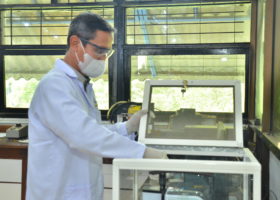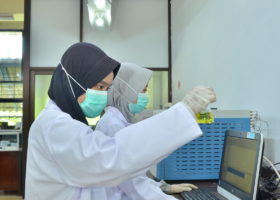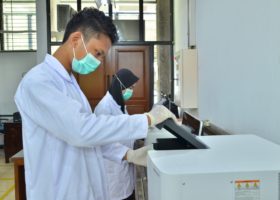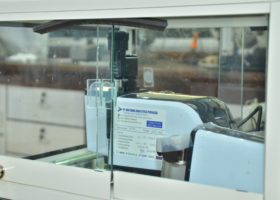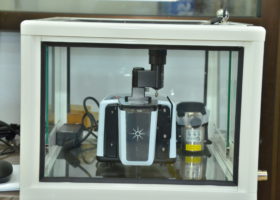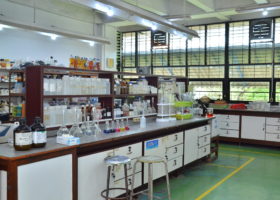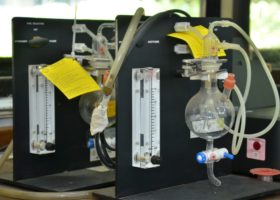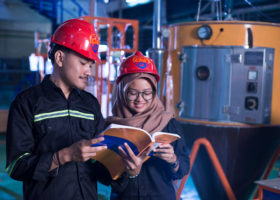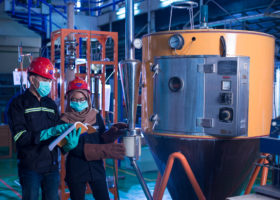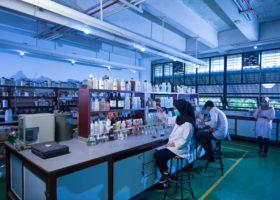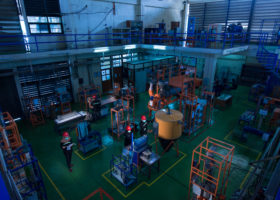Pre Design Factory with the title “FRACSINATION OF LIGNOSELLULOSE FROM PALM OIL FRUGS WITH STEAM EXPLOSION METHOD AND VARIATION OF LIGNIN ISOLATION”
presented by study group students at the Biochemical Engineering Laboratory, Department of Chemical Engineering, Sepuluh Nopember Institute of Technology
The raw material for this fractionation plant is empty palm oil bunches with supporting raw materials in the form of ethanol, NaOH and H2SO4. There are 2 main processes in this fractionation plant, namely the pretreatment process and the fractionation process. The pretreatment process aims to open the lignocellulosic structure so as to facilitate the next process, namely fractionation and can increase yield. The fractionation process aims to separate the components of lignocellulose consisting of cellulose, hemicellulose and lignin which can be utilized according to their respective potentials.
The pretreatment process begins by moving the OPEFB from the OPEFB storage warehouse using a belt conveyor to the washing tank to wash the OPEFB. The purpose of the washing is to clean OPEFB from impurities with a volume of 1:15 washing water for 10 minutes. After washing, the OPEFB is transferred back using a belt conveyor to a shredder which serves to reduce the OPEFB size to approximately 20 mm so that it can expand the OPEFB surface. Then, EPEFB measuring 20 mm is fed using a screw conveyor to the steam explosion reactor. In addition to EFB, saturated steam at a temperature of 190℃ with high pressure is also injected into a steam explosion reactor which then undergoes decompression. The process that occurs in the steam explosion reactor lasts for 15 minutes and can change the cell wall structure in OPEFB so that it can make it easier for the fractionation process. The output from the steam explosion reactor is then fed to the flash tank to separate the steam and slurry. Steam that has been separated goes to the condenser to be condensed and becomes waste water. The slurry output from the flash tank then goes to the next process for fractionation.
The next step is to enter the area of the fractionation process which begins with the separation of hemicellulose by filtration and washing the slurry in a horizontal belt filter. Filtration and washing aims to dissolve the hemicellulose, due to the hydrophilic nature of hemicellulose. The output from the horizontal belt filter is in the form of filtrate containing hemicellulose and cake containing cellulose and lignin. The filtrate is fed to the hemicellulose settling tank which is then added with ethanol in a volume ratio of 3:1 which functions to precipitate the hemicellulose from the filtrate so that hemicellulose precipitate is obtained. The operating conditions in the hemicellulose deposition process took place at 30 for 4 hours. Furthermore, to separate the hemicellulose deposits from the mixture, an evaporation process is needed using an evaporator. Heating media in the evaporator uses steam, which then exits to the condenser to be condensed and becomes waste water. The hemicellulose precipitate that has been separated from the mixture is transferred using a belt conveyor to be stored in a hemicellulose storage tank.
After obtaining the hemicellulose product, then proceed with the separation of cellulose by alkaline delignification to dissolve the lignin. In the delignification process, the alkali cake from the horizontal belt filter will be reacted with 1% NaOH concentration (ratio of weight per volume). To obtain NaOH with a concentration of 1%, 50% NaOH was diluted from the storage tank for NaOH raw materials with a certain amount of water, so that NaOH with a concentration of 1% was obtained. Cake from the horizontal belt filter is fed using a bucket elevator to the delignification reactor which is also added with 1% NaOH solution with a ratio of 20:1. The process in the delignification reactor takes place at a temperature of 100℃ with the heating medium in the form of steam for 1 hour with a stirring speed of 80 rpm. The slurry from the delignification reactor is then fed to the horizontal belt filter where the horizontal belt filter contains filtration and washing processes. Filtration serves to separate the cellulose from the filtrate in the form of lignin and washing serves to lower the temperature of the cellulose before being stored in the product storage tank. Cellulose that has experienced a decrease in temperature will then be transferred using a belt conveyor to a storage tank for cellulose products.
The last process is the filtrate containing lignin is pumped to the neutralization and precipitation reactor, H2SO4 is added to the reactor which aims to lower the pH of the filtrate as well as to precipitate lignin. The process that occurs in the neutralization and precipitation reactor takes place at a temperature of 80℃ with the heating medium in the form of steam for 10 minutes. The slurry from the neutralization and precipitation reactor is then fed to the horizontal belt filter where the horizontal belt filter is located where on the horizontal belt filter there is a filtration and washing process. Filtration serves to separate the cellulose from the filtrate in the form of lignin and washing serves to lower the temperature of the cellulose before being stored in the product storage tank. Cellulose that has experienced a decrease in temperature will then be transferred using a belt conveyor to a storage tank for cellulose products.
The last process is the filtrate containing lignin is pumped to the neutralization and precipitation reactor, H2SO4 is added to the reactor which aims to lower the pH of the filtrate as well as to precipitate lignin. The process that occurs in the neutralization and precipitation reactor takes place at a temperature of 80℃ with the heating medium in the form of steam for 10 minutes. The slurry from the neutralization and precipitation reactor is then fed to the horizontal belt filter where the horizontal belt filter contains filtration and washing processes. The filtration process serves to separate the lignin that has been deposited with its residue and the washing function to lower the temperature of the lignin before being stored in the product storage tank. Lignin that has decreased in temperature will then be transferred using a belt conveyor to the lignin product reservoir.
